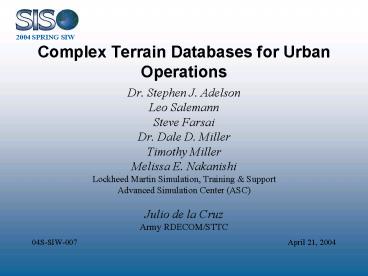Complex Terrain Databases for Urban Operations - PowerPoint PPT Presentation
1 / 28
Title:
Complex Terrain Databases for Urban Operations
Description:
Use xml damage to cull x3d polygons for clipping. Transmit damage information ... Damaging the more abstract .xml file allows better culling of 'real' polygons. ... – PowerPoint PPT presentation
Number of Views:41
Avg rating:3.0/5.0
Title: Complex Terrain Databases for Urban Operations
1
Complex Terrain Databases for Urban Operations
- Dr. Stephen J. Adelson
- Leo Salemann
- Steve Farsai
- Dr. Dale D. Miller
- Timothy Miller
- Melissa E. Nakanishi
- Lockheed Martin Simulation, Training Support
- Advanced Simulation Center (ASC)
- Julio de la Cruz
- Army RDECOM/STTC
- 04S-SIW-007
April 21, 2004
2
Urban Operations (UO)
- Urban Operations require
- Dense, realistic cityscapes
- Thousands, if not MILLIONS of buildings
- Reasonable database generation times
3
LM STS Jakarta
1.8 million buildings
4
Database Generation Time
- 1.8 million buildings (Jakarta)
- typical system can generate one building per
minute - _____
- 42 machine months generation time
- Excluding human-in-the-loop processing.
- NOT ACCEPTABLE
5
ABGS / UHRBSim Alternative
- Automated Building Generation System (ABGS)
- Attributed, textured simple building in under a
second - Automated process
- Implies 1.8 million buildings in 21 processing
days - Ultra-High Resolution Building Simulator
(UHRBSim) - Simulates damage to complex buildings in
real-time operations - Similar to DTSim for terrain
6
ABGS Process Overview
7
ABGS Step 1 Data Preparation (1)
- Building Footprints
- Two dimensional building outlines (shapefile)
- Urban Terrain Zones (UTZ)
- Large 2D polygons of similar building clustering,
from source or automatic/manual derivation from
imagery. - Terrain Imagery (If UTZs are incomplete)
- Correlated 1-5m pixel images
- Road Networks
- Linear features correlated with building
footprints, used to determine the front of
buildings.
8
ABGS Step 1 Data Preparation (2)
- Footprint, UTZ, and Road attribution based on the
Environmental Data Model (EDM) for Ultra-High
Resolution Buildings (UHRB) - UHRB-EDM is a simplification of the OneSAF
Objective System (OOS) EDM - Dropped Abstract and Generalized features in
favor of a more explicit hierarchy. - Reduced feature set to the core features
necessary for a building with a basic interior. - Attribution reduced to just those which support a
visual representation.
9
ABGS Step 2 Attribution Generation (1)
10
ABGS Step 2 Attribution Generation (2)
- Root Segment Generation
- Use the building footprints and correlated roads
to calculate front door
11
ABGS Step 2 Attribution Generation (3)
- Attribution Rules Configuration
- Driven by a database of allowable values and
probabilistic value distribution - Utilize UTZs to determine building type
- Analyze footprint for most likely building match
- Derive building function, building floor count,
building heights, and number of floors
12
ABGS Step 2 Attribution Generation (4)
- Attribute Generation
- Assign attributes to buildings based on the
attribution rules - Largely automatic, manual intervention possible
13
ABGS Step 2 Attribution Generation (5)
- Verification Phase (optional)
- Edit buildings using common GIS tools
- Check for aesthetic distribution of building
heights - Check building type distribution
- Manually address special cases, e.g. landmarks
14
ABGS Step 2 Attribution Generation (6)
- InteriorGen
- Generates basic format of building interiors,
with attribution - Automated process, using ARC GIS tools / ESRI
GeoDatabases
15
ABGS Step 2 Attribution Generation (7) Typical
InteriorGen Output
16
ABGS Step 2 Attribution Generation (8)
- InteriorGen Operational Steps
- Hallway line generation
- Shaft creation
- Hallway areas
- Room areas
- Door points and lines
- Shapefile export
17
ABGS Step 3 Floorplan Generation
- Generates abstract 3D building
- Includes walls, but no clipping or triangulation
- Attributes come from several sources
- Directly from the InteriorGen exported shapefile
- Default values from UHRB EDM
- Derived (e.g., number of rooms, window width)
- Fully automated process
- Output (xml files) used to build MESs in CTDB
18
ABGS Step 4 Polygon Generation (1)
- Takes a Floorplan (xml) and creates explicit
polygons (x3d) - Performs all clipping and texturing
19
ABGS Step 4 Polygon Generation (2)
- Fully automated process
- Output used for visual database, and real-time
damage algorithms
20
ABGS Step 4 Polygon Generation (3)
21
UHRBSim Real-Time Modifications (1)
22
UHRBSim Real-Time Modifications (2)
- Similar to DTSim, reuses existing technology
- DTScribe for reliability
- Coverages / specific HLA interactions for
readability - Uses ABGS .xml and .x3d files as DTDB
23
UHRBSim Operation (1)
- UHRBSim Operations
- Listen for detonations
- Determine Affected Buildings
- Damage .xml files
- Use xml damage to cull x3d polygons for clipping
- Transmit damage information
24
UHRBSim Operation (2)
- Listen for Detonations
- Currently listens for c4 (UO focus)
- Could listen for any potentially damaging
munition - Determine Affected Buildings
- Gather buildings within the blast radius
- MSO database (derived from ABGS output) contains
the location of .xml and .x3d file for each
building
25
UHRBSim Operation (3)
- Damage .xml file (1)
- Damaging the more abstract .xml file allows
better culling of real polygons. - E.g., a single wall polygon corresponds to many
.x3d polygons - Only .xml action is to add apertures to existing
structures
26
UHRBSim Operation (4)
- Damage .xml file (2)
- Generate blast outline
- Project to surfaces
- Creates ice cream scoop effect
- Effective for small munitions (c4)
- Gather damaged surfaces
27
UHRBSim Operation (5)
- Damage .x3d file
- Naming convention allows association between .xml
surface and .x3d polygons, for efficient culling
- Clipping may not actually occur
28
Future Directions
- More complex buildings
- Level of Detail
- Non-building structures
- Incremental database generation
- More robust damage assessment, including rubble
- More variable attribution
- Optimized Storage































